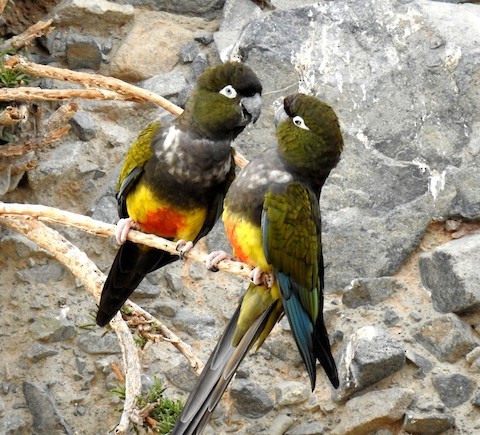Birdfinding.info ⇒ A spectacular colonial parakeet whose populations appear to have stabilized after long-term declines. The largest colony, with over half of the global population, is at El Condór Beach in Río Negro, Argentina. Other areas where it can often be found include: in Argentina, Cafayate (Salta), Tafí del Valle (Tucumán), Talampaya National Park (La Rioja), El Carrizal (Mendoza), Mogote Bayo Nature Reserve (San Luís), Casa de Piedra and Veintecinco de Mayo (La Pampa), San Martin de los Andes (Neuquén), Las Grutas (Río Negro), Puerto Madryn (Chubút); and in Chile, Bramaderos and Santa Gracia (Coquimbo), Río de Los Cipreses Nature Reserve (O’Higgins), and Lago Colbún (Maule). On Hawaii’s Big Island, an introduced flock can sometimes be found around Kahaluu-Kaeuhou.
Burrowing Parakeet
Cyanoliseus patagonus
Temperate grasslands and dry brushlands of southern South America. Breeds colonially in burrows and crevices in bluffs and cliffs, often in canyons and along watercourses. Often occurs in towns and agricultural areas, where it adapts to manmade structures.
Four major populations are recognized as separate subspecies: (1) bloxomi in the western Andean foothills of central Chile; (2) andinus in the Andean foothills of northwestern Argentina; (3) conlara in the hill country of central Argentina; and (4) patagonus of Patagonia.
The Chilean subspecies was formerly widespread, but has become localized in two separate areas: north-central in Atacama and Coquimbo; and south-central in O’Higgins and Maule.
In Argentina, the northwestern subspecies occurs from Salta to northern San Juan and La Rioja, the central subspecies from Mendoza to Córdoba, but mostly in San Luís, and the Patagonian subspecies from Neuquén and Río Negro to southern Chubút.
The colony at El Condór Beach at the mouth of the Río Negro reportedly numbers around 35,000 pairs. The remaining Argentine populations have been estimated at approximately 2,000 pairs in the northwest, 850 pairs in the middle, and 8,000 pairs in Patagonia. In 2011 the Chilean population was estimated at between 2,500 and 3,000 pairs.
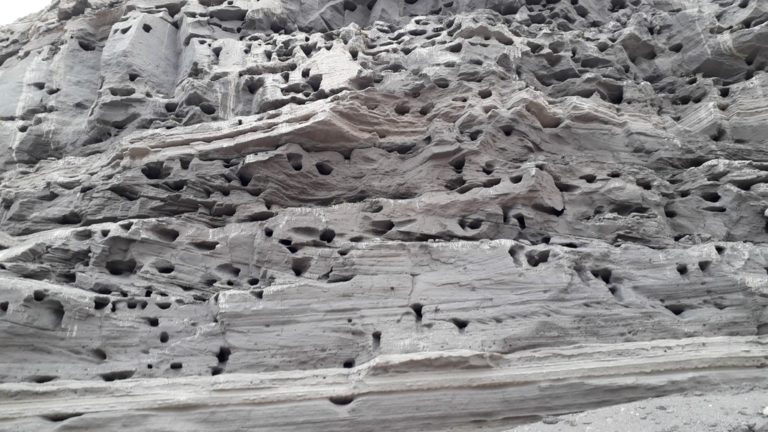
Burrowing Parakeet colony. (El Condór Beach, Río Negro, Argentina; April 13, 2019.) © Emiliano Lautaro Ferrero
When not breeding, some portion of the Patagonian population disperses northeastward across the pampas of La Pampa and Buenos Aires Province, occasionally into Uruguay.

Burrowing Parakeet colony, interpretive sign. (El Condór Beach, Río Negro, Argentina; April 13, 2019.) © Emiliano Lautaro Ferrero
A small flock of escapees appeared along the western coast of Hawaii’s Big Island in 1990 and has grown into a small introduced population, with up to 32 birds reported in 2020.
Identification
A very large, brown-and-olive parakeet with vivid blue wings, yellow-to-red belly, yellow back and rump, and white eyes with bright-white orbital skin.
The head is mostly deep olive with a strongly contrasting, teardrop-shaped white area around the eye. The bill is generally dark gray, but immatures have a pale upper mandible.
The breast is an earthy grayish-brown, usually with a pale spot or crescent at the side of the neck.
The belly is brightly colored but somewhat variable, both regionally and individually. On some birds it is all-yellow, on some it is mostly reddish, but most are ruby-red in the center and become progressively orange outward, then yellow at the edges—giving the impression of a glowing coal.

Burrowing Parakeet, C. p. patagonus, generally the most brightly colored subspecies. (Costa Bonita, Necochea, Buenos Aires Province, Argentina; November 24, 2018.) © Pablo Alejandro Pla

Burrowing Parakeet, C. p. patagonus, showing vivid red-and-yellow belly, as is typical of this subspecies. (Puerto Madryn, Chubút, Argentina; November 3, 2018.) © Richard Greenhalgh
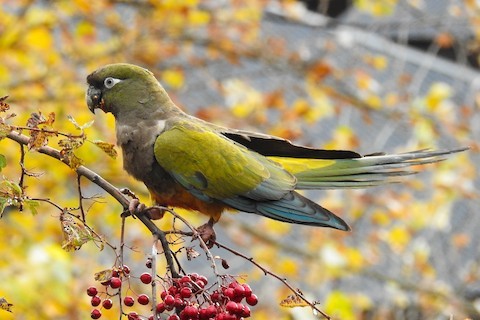
Burrowing Parakeet, C. p. patagonus. (San Martin de los Andes, Neuquén, Argentina; May 9, 2020.) © José Fernández Piñar
Geographical Variation. The northwestern subspecies, andinus, is generally the darkest and dullest overall, with muted yellowish-olive and a reddish blush on the belly.
The Patagonian subspecies, patagonus, is generally the most colorful, and the central Argentine subspecies, conlara, is transitional.
The Chilean subspecies, bloxomi, differs from the others in having more yellow and less red on the belly and a more pronounced pale breastband, which varies from dull and partial to white and complete.
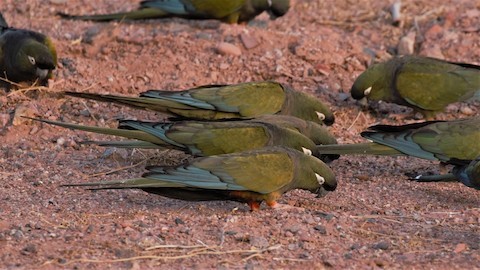
Burrowing Parakeet, C. p. andinus, generally the dullest subspecies. (Talampaya National Park, La Rioja, Argentina; September 22, 2019.) © José Luis Blázquez

Burrowing Parakeet, C. p. patagonus. (Puerto Madryn, Chubút, Argentina; November 3, 2018.) © Richard Greenhalgh
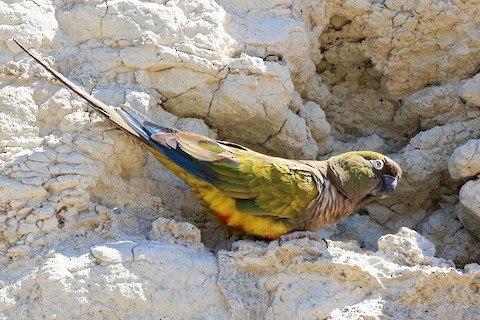
Burrowing Parakeet, C. p. patagonus. (Las Grutas, San Antonio, Río Negro, Argentina; January 2, 2017.) © Phillip Edwards
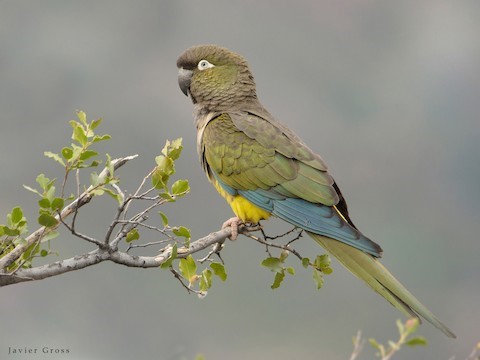
Burrowing Parakeet, C. p. bloxami. (Mirador Sendero Los Tricahues, Río de Los Cipreses Nature Reserve, O’Higgins, Chile; July 17, 2019.) © Javier Gross

Burrowing Parakeet, C. p. andinus, generally the dullest subspecies, but still brightly colored. (Cachi, Salta, Argentina; August 27, 2012.) © Marco Valentini

Burrowing Parakeet, C. p. andinus. (El Chiflón Provincial Park, La Rioja, Argentina; November 17, 2018.) © Hugo Hulsberg
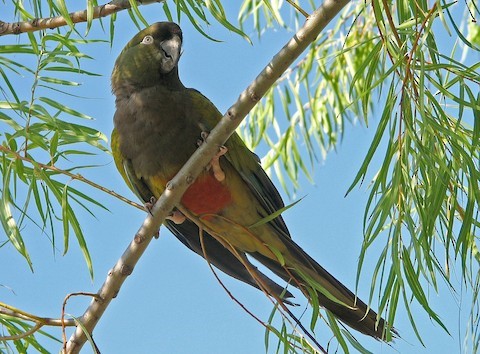
Burrowing Parakeet, C. p. conlara—apparently this intermediate subspecies, but could be patagonus instead. (Costanera Sur Ecological Reserve, Buenos Aires, Argentina; January 28, 2006.) © Hugo Hulsberg
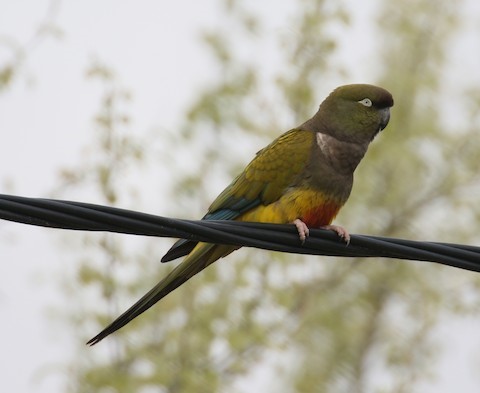
Burrowing Parakeet, C. p. patagonus, showing a bronzy tint on the upperparts. (Punta Pirámides, Chubút, Argentina; September 26, 2018.) © Simon Walkley
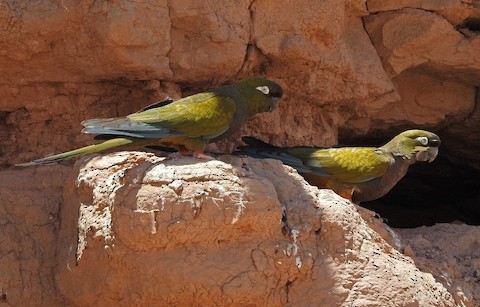
Burrowing Parakeet, C. p. andinus, at nest site. (Arauca, La Rioja, Argentina; November 11, 2018.) © Hugo Hulsberg

Burrowing Parakeet, C. p. andinus, at nest site. (Alto Jague, Vinchina, La Rioja, Argentina; September 25, 2019.) © José Luis Blázquez

Burrowing Parakeet, C. p. bloxami, at nest site. (La Serena, Coquimbo, Chile; May 28, 2018.) © Fernando Angulo
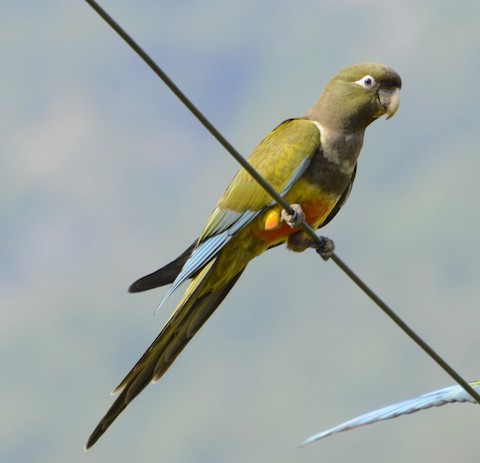
Burrowing Parakeet, C. p. bloxami. (Paso Nevado, San Clemente, Maule, Chile; January 19, 2020.) © Daniel Martínez
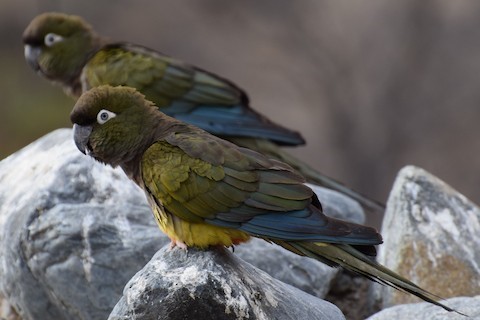
Burrowing Parakeet, C. p. bloxami. (Bramaderos, La Higuera, Coquimbo, Chile; October 23, 2016.) © Gabriele Vallejos
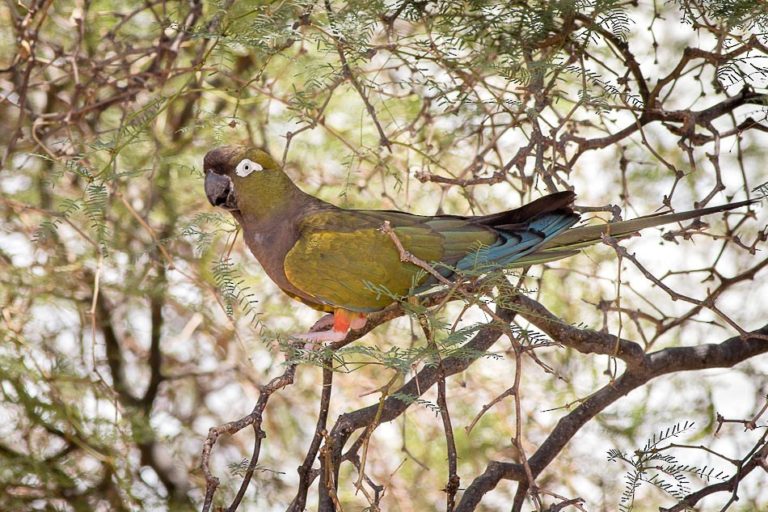
Burrowing Parakeet, C. p. andinus. (Casa de Piedra, Catamarca, Argentina; December 8, 2017.) © Jorge Schlemmer

Burrowing Parakeet, C. p. andinus, showing dull belly coloration, as is typical of this subspecies. (Cafayate, Salta, Argentina; December 20, 2008.) © Pam Rasmussen

Burrowing Parakeet, C. p. andinus. (Cachi, Salta, Argentina; August 27, 2012.) © Marco Valentini
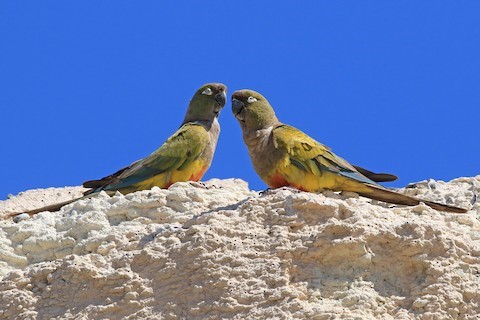
Burrowing Parakeet, C. p. patagonus. (Las Grutas, San Antonio, Río Negro, Argentina; January 2, 2017.) © Phillip Edwards

Burrowing Parakeet, C. p. bloxami. (Bramaderos, La Higuera, Coquimbo, Chile; November 18, 2017.) © Sakia Hostens
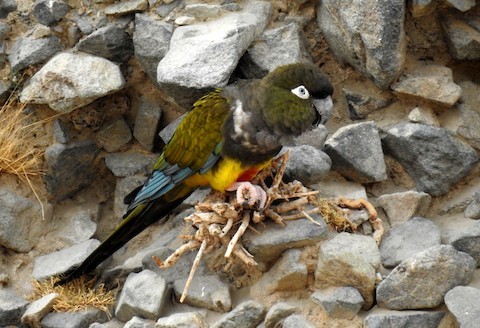
Burrowing Parakeet, C. p. bloxami. (La Serena, Coquimbo, Chile; May 28, 2018.) © Fernando Angulo
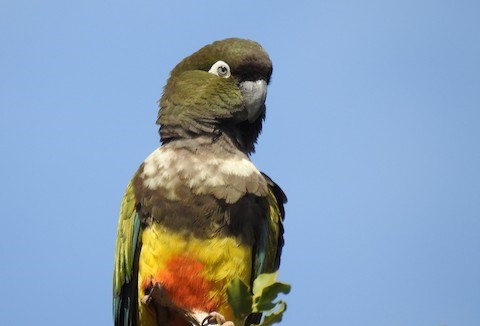
Burrowing Parakeet, C. p. bloxami, showing extensive whitish breastband and bright red-and-yellow belly. (Río de Los Cipreses Nature Reserve, O’Higgins, Chile; August 4, 2020.) © Pablo Gutiérrez Maier
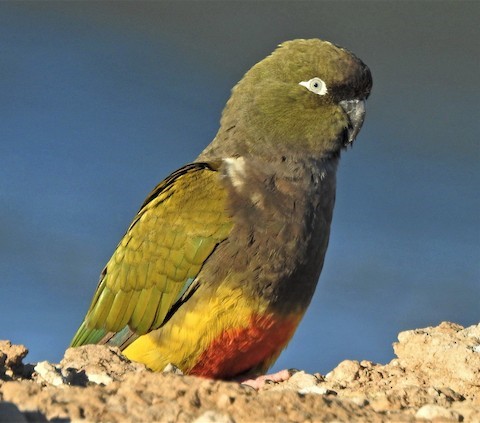
Burrowing Parakeet, C. p. patagonus. (Necochea, Buenos Aires, Argentina; June 3, 2019.) © Hugo Hulsberg
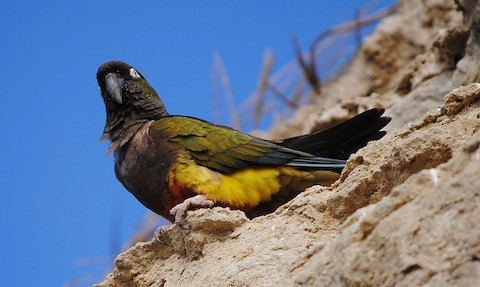
Burrowing Parakeet, C. p. patagonus. (Punta Tombo, Florentino Ameghino, Chubút, Argentina; November 29, 2010.) © Andrés Ebel

Burrowing Parakeet, C. p. bloxami, showing extensive whitish breastband. (Río de Los Cipreses Nature Reserve, O’Higgins, Chile; August 4, 2020.) © Pablo Gutiérrez Maier

Burrowing Parakeet, C. p. andinus, immature showing pale upper mandible and dark eye. (Ruinas de Quilmes, Tafí del Valle, Tucumán, Argentina; April 18, 2018.) © Hugo Hulsberg

Burrowing Parakeet, C. p. patagonus, immatures showing pale upper mandibles and dark eyes. (Casa de Piedra, Puelén, La Pampa, Argentina; January 18, 2015.) © Pablo Alejandro Pla

Burrowing Parakeet, C. p. andinus. (La Poma, Salta, Argentina; November 25, 2017.) © Jorge Quiroga

Burrowing Parakeet, C. p. andinus. (Cachi, Salta, Argentina; January 13, 2016.) © Marcelo Molina

Burrowing Parakeet, C. p. bloxami, showing extensive whitish breastbands. (Mirador Sendero Los Tricahues, Río de Los Cipreses Nature Reserve, O’Higgins, Chile; July 17, 2019.) © Javier Gross

Burrowing Parakeet, C. p. bloxami, showing extensive whitish breastbands. (La Serena, Coquimbo, Chile; May 28, 2018.) © Fernando Angulo

Burrowing Parakeet, C. p. bloxami, showing extensive whitish breastbands. (Río de Los Cipreses Nature Reserve, O’Higgins, Chile; September 9, 2018.) © Pablo Gutiérrez Maier
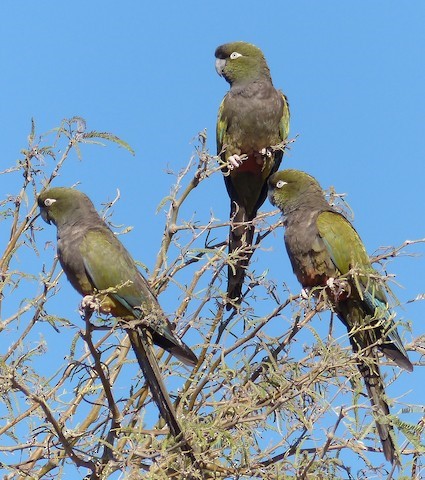
Burrowing Parakeet, C. p. andinus. (Seclantas, Molinos, Salta, Argentina; October 25, 2016.) © Stéphane Thomin

Burrowing Parakeet, C. p. andinus. (Río Seco, Cafayate, Salta, Argentina; November 24, 2017.) © Patrick Monney
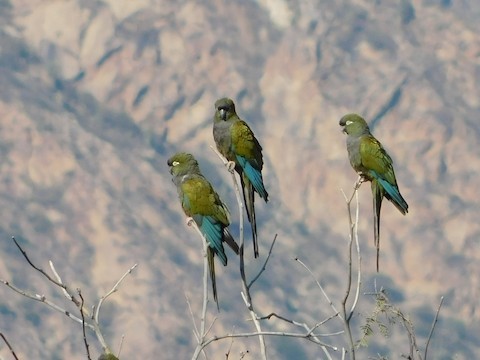
Burrowing Parakeet, C. p. andinus, appearing mostly olive with blue wings. (San Carlos, Cafayate, Salta, Argentina; May 20, 2019.) © Nicolás Bejarano
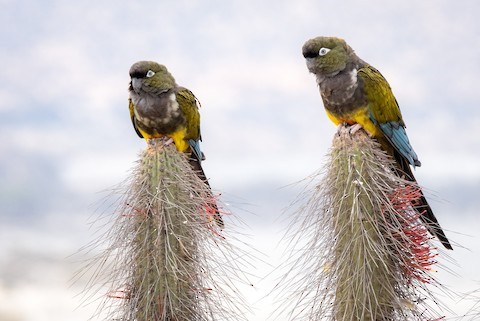
Burrowing Parakeet, C. p. bloxami. (Santa Gracia, La Serena, Coquimbo, Chile; March 15, 2019.) © Rodrigo Moraga

Burrowing Parakeet, C. p. bloxami, showing extensive whitish breastbands. (La Serena, Coquimbo, Chile; May 28, 2018.) © Fernando Angulo
In flight, the underwings and undertail are mostly dark brown. On the uppersides the tail and inner coverts are bright olive and the outer coverts and flight feathers are ultramarine blue.
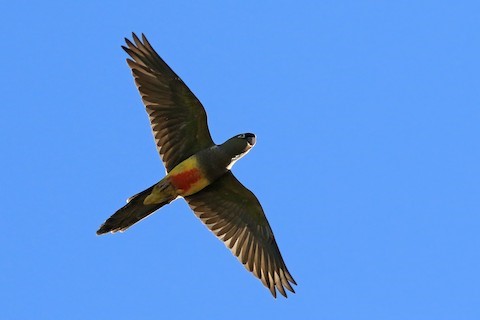
Burrowing Parakeet, C. p. patagonus, showing vivid red-and-yellow belly, as is typical of this subspecies. (Las Grutas, San Antonio, Río Negro, Argentina; January 2, 2017.) © Phillip Edwards

Burrowing Parakeet, C. p. bloxami, showing whitish breastband and mostly yellow belly, which are typical of this subspecies. (Lago Colbún, San Clemente, Maule, Chile; March 29, 2018.) © Vicente Pantoja Maggi
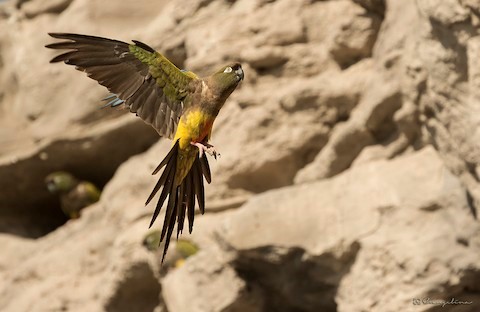
Burrowing Parakeet, C. p. patagonus, showing pale breastband and mostly yellow belly, which are not typical of this subspecies. (Villa Marítima El Cóndor, Río Negro, Argentina; January 6, 2019.) © Evangelina Indelicato
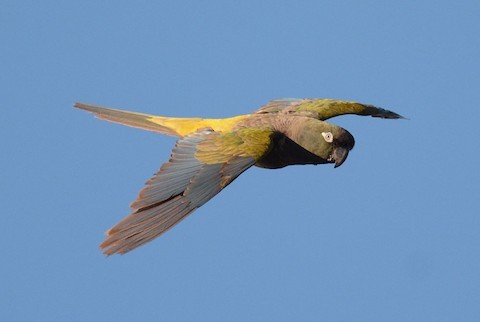
Burrowing Parakeet, C. p. patagonus. (Las Grutas, San Antonio, Río Negro, Argentina; November 28, 2015.) © Mark van Beirs

Burrowing Parakeet, C. p. patagonus. (Puerto Madryn, Chubút, Argentina; November 3, 2018.) © Richard Greenhalgh

Burrowing Parakeet, C. p. bloxami. (Río de Los Cipreses Nature Reserve, O’Higgins, Chile; September 9, 2018.) © Pablo Gutiérrez Maier
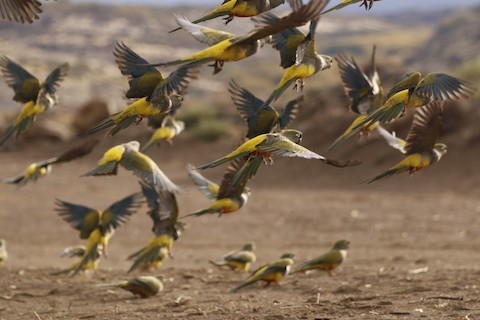
Burrowing Parakeet, C. p. patagonus. (Laguna Espejo, Loncopué, Neuquén, Argentina; May 13, 2017.) © Cecilia de Larminat

Burrowing Parakeet, C. p. patagonus, showing vivid red-and-yellow belly, as is typical of this subspecies. (Punta Tombo, Florentino Ameghino, Chubút, Argentina; November 29, 2010.) © Andrés Ebel
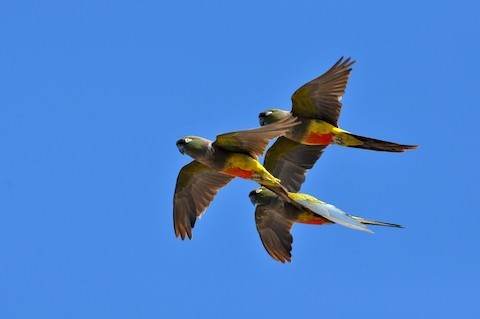
Burrowing Parakeet, C. p. patagonus, showing vivid red-and-yellow belly, as is typical of this subspecies. (Villa Marítima El Cóndor, Río Negro, Argentina; January 5, 2017.) © Fermin Zorrilla
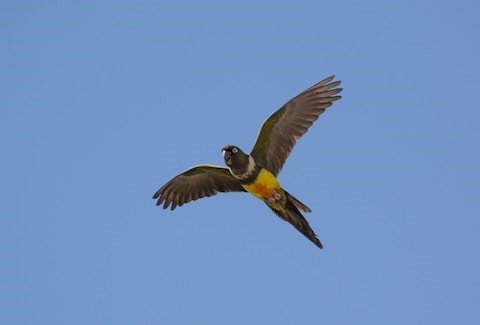
Burrowing Parakeet, C. p. bloxami, showing whitish breastband and mostly yellow belly, which are typical of this subspecies. (Río de Los Cipreses Nature Reserve, O’Higgins, Chile; September 12, 2014.) © Natacha Francisca
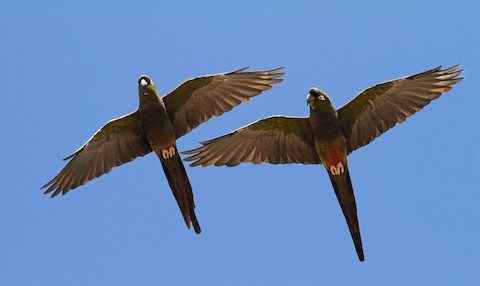
Burrowing Parakeet, C. p. andinus, showing dull belly coloration, as is typical of this subspecies. (Quebrada de las Conchas, Cafayate, Salta, Argentina; August 5, 2013.) © Ian Davies
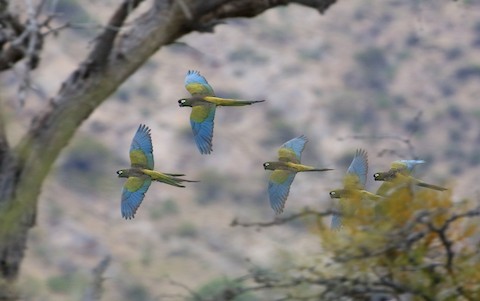
Burrowing Parakeet, C. p. andinus. (Río Seco, Cafayate, Salta, Argentina; November 24, 2017.) © Patrick Monney
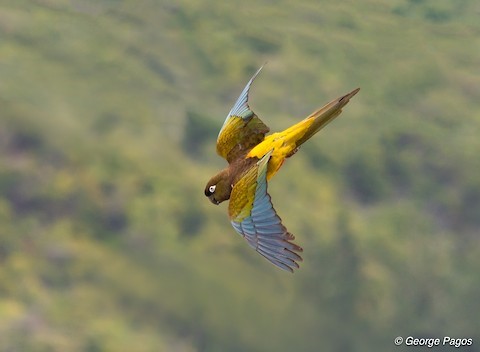
Burrowing Parakeet, C. p. bloxami. (Paso Nevado, San Clemente, Maule, Chile; November 4, 2019.) © George Pagos
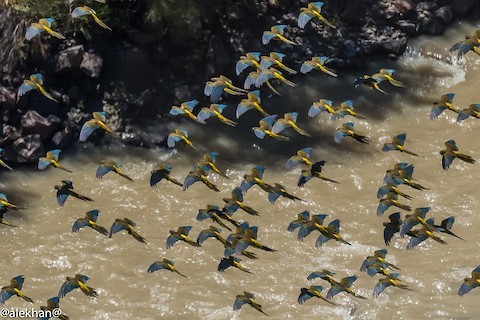
Burrowing Parakeet, C. p. bloxami, flock in flight, showing blue wings and yellow rumps. (Estero las Terneras, Río de Los Cipreses Nature Reserve, O’Higgins, Chile; January 10, 2015.) © Eleuterio Ramirez
Notes
Polytypic species consisting of four recognized subspecies. Sometimes regarded as comprising three distinct forms: “Chilean” (bloxami), “Olive” (andinus), and “Patagonian” (patagonus and conlara).
References
BirdLife International. 2018. Cyanoliseus patagonus. The IUCN Red List of Threatened Species 2018: e.T22685779A132255876. https://dx.doi.org/10.2305/IUCN.UK.2018-2.RLTS.T22685779A132255876.en. (Accessed October 1, 2020.)
de la Peña, M.R., and M. Rumboll. 1998. Birds of Southern South America and Antarctica. Princeton University Press.
eBird. 2020. eBird: An online database of bird distribution and abundance. Cornell Lab of Ornithology, Ithaca, N.Y. http://www.ebird.org. (Accessed October 1, 2020.)
Forshaw, J.M. 2010. Parrots of the World. Princeton University Press, Princeton, N.J.
Juniper, T., and M. Parr. 1998. Parrots: A Guide to Parrots of the World. Yale University Press.
Pyle, R.L., and P. Pyle. 2017. The Birds of the Hawaiian Islands: Occurrence, History, Distribution, and Status. Version 2 (January 1, 2017). http://hbs.bishopmuseum.org/birds/rlp-monograph/. B.P. Bishop Museum, Honolulu, Hawaii.
Xeno-Canto. 2020. Burrowing Parrot – Cyanoliseus patagonus. https://www.xeno-canto.org/species/Cyanoliseus-patagonus. (Accessed October 1, 2020.)
